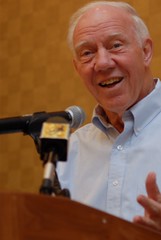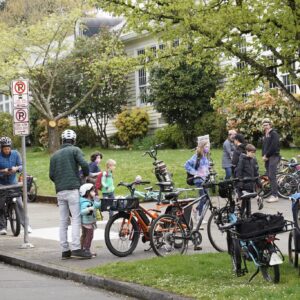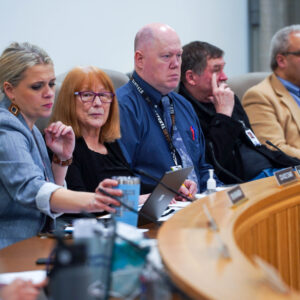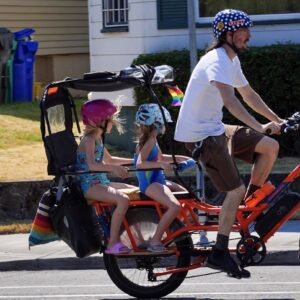“Over reliance on automobiles can have adverse impacts on public health, both through lessened physical activity and from increased pollutants.”
— from the bill’s description of the Office of Livability
U.S. Rep. Jim Oberstar, Chairman of the House Transportation and Infrastructure Committee has released the full text of the federal transportation bill. Calling it the “Surface Transportation Authorization Act of 2009,” the 775-page document lays out every facet of how the United States manages its transportation system.
Last week we speculated what the bill might include and now we’ve got the real deal. I’ve been combing through it and looking for bike-related bits. So far, the most interesting section is the full description of the new Office of Livability.
If established as drafted in this bill, this new Office could be a very exciting step for biking in America.
The 20-page description of the Office of Livability begins by laying out the case against the status quo:
“Since the creation of the Interstate System, American surface transportation has been defined by the use of personal motor vehicles. The focus on automobiles has afforded Americans increased mobility and interconnectivity; yet has also lead to increased congestion, higher greenhouse gas emissions, and a reduced focus onother modes of surface transportation.”
I’d say given what “the focus on automobiles” has done to this country, that’s putting it nicely. The bill then backs up some of those claims:
“Between 1955 and 2005, vehicle miles traveled in the United States increased fivefold, bringing with it an escalation in traffic congestion.
Each year, Americans spend 4,200,000,000 hours in traffic congestion, burning 2,900,000,000 gallons of fuel.
Wasted time and fuel result in a $78,000,000,000 annual congestion tax, creating a financial drain on individual passengers and the economy as a whole.
…Over reliance on automobiles can have adverse impacts on public health, both through lessened physical activity and from increased pollutants.”
Then the bill makes the case for non-highway modes:
“Public transit, walking, and cycling are sustainable modes of transportation that result in 5,600,000,000 gallons of fuel savings and reduce carbon dioxide emissions by 49,000,000 metric tons each year.
Sustainable modes of transportation can provide affordable transportation choices and have the ability to reduce the transportation cost burden.”
After that, there’s a phrase I’ve never heard before. The bill refers to “cyclists and pedestrians” as “intended users” (I love this because it makes the point that the current system is not intended for people who walk and bike):
“Cyclists and pedestrians are intended users of the surface transportation system, except where prohibited by law; and it is the policy of the Federal Government to encourage maximum accessibility and safety of the surface transportation system for cyclists and pedestrians as intended users when designing and constructing surface transportation facilities.”
(If this passes, I want a T-shirt that has “Intended User!” emblazoned on the back.)
After the introduction, the bill describes what roles the Director of the Office of Livability (wonder who will be picked for that post?) would be responsible for. Among the expected oversight duties (like Transportation Enhancements, Safe Routes to Schools, and other bike-related programs), there are some new ones that reflect Oberstar’s understanding of where major gaps remain in strengthening the role of the bicycle in American life.
The Office of Livability would manage the “Development of statistical and analytic capabilities.” The office would oversee research to determine things like the percentage of trips taken nationally for transit, motor vehicles and walking and biking; and the economic, public health, and environmental benefits of “sustainable modes of transportation.”
Better research to combat the auto-centric paradigm has been on everyone’s mind lately. Bikes Belong recently hosted a summit of bike researchers and U.S. Rep. Earl Blumenauer has said better research is one of his top priorities.
“The Director [of the Office of Livability] shall conduct a study on whether State and local laws and the actions of judicial systems are affording cyclists and pedestrians who are injured or suffer property damage… the same ability to recover damages… as would be available to persons in motor vehicles.”
— from the bill text
Perhaps the most surprising find so far in the bill text is that it directs the leader of the Office of Livability to conduct a study on the rights of cyclists and pedestrians. Back in March, I hinted that Oberstar was interested in this topic, so it’s neat to see it come to life in the official bill.
As written, the bill says the study should look into how (or if) state and local laws deal with the, “rights of cyclists and pedestrians to use transportation facilities and to be intended and permitted users of these facilities”. The study would also look into whether state/local laws and the courts “are affording cyclists and pedestrians who are injured in collisions, “the same ability to recover damages for their injuries as would be available to persons in motor vehicles suffering comparable injuries.”
The Office of Livability would also be directed to report back to Congress with results from the study and recommendations on how to improve the laws for people who walk and bike.
There’s a long road ahead for this bill and there are no funding numbers attached yet. But, at first glance, it seems to include some big wins for biking.
Stay tuned for more coverage.
Download the full bill over at Transportation for America.







Thanks for reading.
BikePortland has served this community with independent community journalism since 2005. We rely on subscriptions from readers like you to survive. Your financial support is vital in keeping this valuable resource alive and well.
Please subscribe today to strengthen and expand our work.
wow interesting read, some drivers should thank me for being one less car. instead
i get pushed around since they think i take up waaay to much space and slow them down.. haha!!
This is great. I only wish we didn’t have to listen to the inevitable chorus of whiny crybabies belly-achin’ about it.
I can already see the veins in Lars temple aflutter..
and all of the Fox radio personalities declaring open war on cyclists.
Jonathan, could you host a design competition for an “intended user” t-shirt? I think we’re not the only ones who’d love one.
This “intended user” would be interested in a tee too… Hmmm a pun would work here…
Ah’l Be Back…
This bill is important not only for environmental reasons, but also because the emphasis on cars in this country helps to create and sustain racial inequity.
A recent book, Highway Robbery, makes this case persuasively: “Coast to coast, equal access to healthy, reliable, and practical transportation eludes many people, the majority of them poor people and people of color. The effects of this injustice are broad and deep. Access to transportation, public and private, determines the physical and social mobility necessary for admission to larger social, economic, and civic worlds. For millions of people, exclusion from transportation networks means drastically compromised life choices. Their jeopardized health and limited economic opportunities are then compounded by the day-to-day indignities and feelings of frustration and isolation resulting from publicly funded segregation.”
Quotation taken from http://www.southendpress.org/2004/items/Highway
Might I suggest that this book be added to the library?
Also, while I’m on the theme of the spatial dynamics of racism, I would like to ask that bikeportland.org do more to cover this issue. I am a huge fan of this site, and would love to see it live up to its potential. Specifically, in pursuit on infill–and much of the livability that Portlanders in the Pearl and N/NE now enjoy–immigrants and poor and working people of color have been driven farther out. I’ll speak of outer SE because I know it best. Areas around 82nd, Lents, 122nd and Rockwood have pitifully few parks, green spaces, and safe places for young people to play. Although there are bike lanes–and I regularly biked to work in this area–the landscape is dominated by inhumanly-scaled roads and cars. If Portland is to become a truly bike-able city, then those who have the most to gain from biking need to be included. I’d also like to hear something about the racial profiling of young men on bicycles. Is this a problem in Portland? In the East Coast city where I live now, young men on bicycles are consistently portrayed in the media and by the police as threats to public safety. Is this a problem in Portland as well, and if so, how is it being addressed? Inquiring minds want to know.
“As written, the bill says the study should look into how (or if) state and local laws deal with the, “rights of cyclists and pedestrians to use transportation facilities and to be intended and permitted users of these facilities”.” maus/bikeportland
I wonder if our intrepid lawmakers are up to the challenge of clarifying and strengthening those rights. “…transportation facilities…” covers a lot of territory…public transportation, train, planes, in addition to streets, roads and highways.
On a simple basis, it’s generally acknowledged that apart from the mode of transportation they choose to use, anyone adhering to the rules of the road has a fundamental right to use the road.
Are any principles road user ‘rights’ actually written down anywhere? Is there a Bill of Road User Rights for the U.S. that specifies ‘motor vehicle operator rights’, ‘pedestrian rights’ ‘cyclists rights’?
Despite that, the fundamental right of road users in general, to use of the road has, with the creation of transportation mode specific road rules and regulations…gradually lost the balance necessary to adequately support people’s right to use the road by means other than motor vehicles.
It’s very encouraging that an inquiry into the “…rights of cyclists and pedestrians to use transportation facilities” is being made part of the transportation bill.
for the T shirt :
on the left,someone with a bicycle “intended user”
on the right someone with a big SUV
“insane user”
There is a lot of talk about “rights” in these posts and then some bashing of the right wing media like FOX. I for one am not a fan of FOX or the whining radio talk show guys, but they also are promoting “rights”. They talk about the rights of the rural farmer to get his crops to market on the road, or the rights of the property owner to not be forced to give up property for a park. Everyone has “rights” but as a society we need to share resources and each give up a little.
Now to talk about the “right” to ride your bike on the road, is it your right or are you just sharing someone else’s right. I think it was those farmers, truck drivers, and car drivers that paid the cost to build those roads that you claim to have a “right” to. I like my neighbor’s pool that he paid for and he lets me use it, but do I have a “right” to it if I do not own it?
I think your argument for bike “rights” to the road goes a lot farther if you are part of the solution to pay for new roads and maintenance of existing roads. Now before people start to think I am a crazy right winger I want you to know I am a long ways to the left, but I just think we all need to be aware of the other side’s point of view. I ride a bike and I drive a car. I like bike paths but I also realize that as a bike rider I am getting a free service.
Do we have a “right” to water? I sure hope we do. Life could not be sustained without it. Do we pay for water? Most of us do. To have a “right” to something I think you better be ready to pay for that “right”.
beerhunter: exactly what ‘free service’ are you refering to? I ride a bike, bus, & car (in that order of frequency); am a homeowner, and full time employed. So I pay my taxes for where I live, where I work, and gas. So I, indeed, pay for the bike lanes I use; and while I fully support building roads that will benefit the farmer & other types of commerce, I also believe that the distribution of funds is disproportionately in favor of motorized vehicles.
No shoulders on a rural road, blind curves in the road, and now there two cars, travelling in opposite directions. Now throw in a cyclist who insists on using this rural road. He is forcing all concerned to make a choice: Do you drive off the road? Do you run headlong into another vehicle, perhaps a bicycle? I believe in sharing the road, but only if it is a road that is safely shareable. It seems that cycling enthusiasts have lost their grip on reality through their insistence upon riding wherever and whenever they like. Yes, yes, alternate modes of transportation are fine. But do you sincerely believe that cars will just disappear? Even the more environmentally correct models will use our roads. The same potential for grave danger will continue to exist. Bike lanes, fine. Adequate shoulders, fine. But don’t get greedy.
Andres, most of the roads in the US, our State and Counties were built with a gas tax paid when you buy gas for a vehicle. I agree 100% that you pay taxes and a lot of taxes as a home owner. Your property tax unless in Washington County does not go towards roads, sidewalks or bike lanes.
Vehicles also pay a licensing fee and most of this goes towards roads, sidewalks and bike lanes. Just the mention of a licensing fee for bikes and you would think you were the president and killed a fly on TV. We all pay for the services we use, if you want more of a service be ready to pay for that.
I do live in Washington County and part of my property tax goes towards road, sidewalks and bike lanes. The County has made a great effort to build wide sidewalks and bike lanes on all their new roads. So, I am already paying for alternative modes with a tax other than gas tax, but I am one that is willing to pay more to use my bike, especially if it means more bike lanes and wider shoulders to ride on.
How does a tax on shoes sound. Then if you ride or walk you are paying for part of the transportation network. Just a thought!
Reality Guy, drive safe and slow down when you see someone in the road. What if that person is your neighbor or a family member?
Reality Guy,
You do drive a car equipped with working brakes, don’t you? I think most cars have to have working brakes to be street legal, but check your local DMV office to be sure.
Your argument is an old one which fortunately has a simple answer. Given the situation you give, the third option is to SLOW DOWN, and wait for safe opportunity to pass. In fact all states have codified this into law. Drivers must drive within their sight distance, otherwise known as the basic speed rule:
811.100 Violation of basic speed rule
Also passing only when safe to pass:
811.410 Unsafe passing on left
You might complain that this is a ridiculous responsibility, having to slow down for cyclists all the time, all that delay, inconvenience and grief. It’s not. The times you encounter cyclists probably aren’t that often. In any case you have to obey this law wherever left turns are permitted on this hypothetical 2-lane road; wherever slow tractor-trailers are allowed; wherever school buses, mail trucks or garbage trucks are expected to stop; wherever sidewalks aren’t provided for pedestrians; wherever deer are expected to cross the road; wherever tree branches or other debris might be in the middle of the road… in other words these laws and the safe driving practices they demand apply everywhere. They’re not that difficult to follow.
beerhunter, once gas taxes rise to the level of the social cost of driving (GHG emission, congestion) I’d be happy to pay my fair share for using public infrastructure. Strap a GPS on my bike and charge me for miles traveled, similar to the plan that LaHood suggested for cars. But that only makes sense if the full social cost of driving a car is already incorporated in a gas or miles traveled tax. Clearly it is not. So given this second best solution, every mile I substitute riding my bike for driving my car benefits society. Until you get the prices right, it makes no sense to tax something that provides a social benefit.
I should consider to pay less taxes if i don’t own a car !
Serena 7, one thing that needs to be treated as the very real problem that it is, is the “free market” in real property. Some city or state somewhere needs to develop the guts to legislate fixed and finite limits on the selling price of land and houses to prevent speculation and/or gentrification.
A roof over one’s head is not optional–it is a necessity. The abillity to afford to live within reasonable distance to one’s work should not be placed at the mercy or whim of speculators, realtors, or developers.
Price limits and rent control have to be a serious part of any energy use strategy. When you have people working in downtown Portland and contemplating houses in Kalama or McMinnville that they can afford, then you have to realize that market forces need to be controlled in the interest of a rational transportation future.